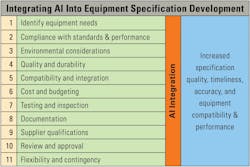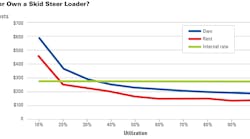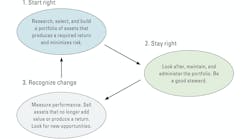Developing sound specifications for construction equipment is a pivotal and crucial phase in ensuring that the equipment fleet meets the standards required to align with the organization’s overarching objectives. Detailed specifications serve as a blueprint for manufacturers and suppliers to tailor equipment offerings precisely to the specific needs of an organization’s equipment requirements, optimizing operational efficiency. Clearly, developing a sound and detailed specification is the best opportunity to secure equipment that meets the demands of the organization's current operations and aligns seamlessly with the anticipated future objectives.
Although writing detailed specifications is among the most essential responsibilities equipment managers must perform, some simply dislike the task as it is tedious, time-consuming, and involves a certain degree of finesse that can be challenging to master. Some struggle with the intricate operational or administrative aspects, often resulting in a poor spec, or forego writing a specification at all, opting for a basic or standard machine.
Read also: Three Steps to a Machine Replacement Decision
Artificial intelligence (AI) tools are now available to refine the specification-development processes. The era of cost-effective equipment management unaided by automated systems has come and gone. Automated management systems house critical information needed for the development of sound specifications. By incorporating AI-driven document-generation tools, managers can automate the creation of equipment specifications, harvesting detailed equipment and operational information saving time and reducing errors in the process. Following are key elements of creating detailed and precise equipment specifications and how AI can enhance the process of each element:
1) Clearly define standards and performance requirements
...including the type and quantity of equipment needed. Specify the purpose and functionality of each piece of equipment, the tasks that it will perform, and specific performance expectations. Ensure that specifications align with industry standards, codes, and regulations applicable to the region of intended utilization. Make sure to incorporate stringent safety standards to safeguard workers and compliance with local safety regulations. Define critical performance criteria such as capacity, speed, power, and fuel efficiency with specific performance levels for each. Consider factors like load capacity, lifting height, digging depth, and reach for specialized equipment.
Read also: Ensure Data Integrity in Fleet Management
AI can analyze vast amounts of historical data from the organization’s previous projects and equipment to identify trends, performance metrics, and equipment preferences. This automated, data-driven approach significantly assists in making informed decisions when specifying equipment for new projects.
2) Identify environmental requirement considerations
...such as emissions standards, noise levels, and fuel efficiency to mitigate the risk of potential violations, fines, and damage to the organization’s reputation. This is especially important where the organization’s project locations have environmental regulations.
AI can assist in the identification and decision to pursue alternatively fueled, environmentally friendly, and energy-efficient equipment and options. This is especially important given the increasing emphasis on sustainability objectives within the construction industry and will align well with the organization’s long-range sustainability goals.
3) Ensure maintenance, serviceability, quality, and durability
...by defining the expected lifecycle of the equipment and quality standards it must meet. Equipment that fails to meet the demands of a construction site can lead to frequent breakdowns, increased repair costs, and reduced lifecycles. Specify safety features, such as operational visibility, safety guards, alarms, automated fire protection, and emergency shutdown systems to reduce the risk of accidents, injuries, and potential liability. Include requirements for ease of maintenance, availability of spare parts, and serviceability to avoid increased downtime, cost, and extended periods of inoperability.
Read also: AI: On the road to limitless potential
AI-driven predictive maintenance systems can analyze equipment usage data to anticipate when maintenance or replacement parts will be needed. This information can be seamlessly incorporated into equipment specifications to develop maintenance cycles, ensure long-term reliability, and reduce downtime.
4) Compatibility and integration
Equipment must seamlessly integrate with other machinery and systems on the construction sites, and specified attachments or accessories must be compatible. Consider factors like the materials utilized on the project or job site, corrosion resistance, and structural integrity.
AI algorithms can optimize equipment selection and evaluate various equipment options or configurations to determine the most cost-effective and efficient choices for a specific function as required. This will automate the selection process for selecting the right equipment size, type, and attachments.
5) Cost, delivery, and lead times
...can be established in an independent budget or cost range for the equipment early in the process. Request detailed pricing information, including warranties and maintenance contracts from projected suppliers. Specify delivery schedules and lead times to ensure equipment availability. Consider factors like shipping, assembly, and training time.
AI can assist in cost estimation by creating an independent cost estimate long before the bidding/negotiating process begins. AI will analyze historical equipment procurement data, current market prices, and budget constraints to ensure that specifications align with the organization’s operational, financial, and sustainability requirements.
6) Testing and inspection
...procedures detail on-site testing and inspection to validate that the equipment meets specifications before final acceptance.
AI systems can assist in quality control by automating and recording the inspection of equipment and its components and operational capabilities ensuring they meet specified standards prior to delivery.
7) Documentation
...includes user manuals, maintenance guides, and warranty information. Specify the format and language of documentation as necessary to reduce difficulty in operating and maintaining the equipment, safety issues, or challenges in warranty claims.
Incorporating AI into identification of specific documentation enhances its usability, reducing challenges in equipment operation, maintenance, safety, warranty claims, and downtime.
8) Supplier qualifications
...such as experience, certifications, and references must be included. Evaluate the reputation and track record of potential suppliers.
AI can automate the process of researching equipment suppliers and products. It will analyze supplier qualifications, customer reviews, and historical performance data to identify reliable and reputable sources for construction equipment.
9) Review and approval
...process for equipment specifications should involve all relevant stakeholders. Be sure to include equipment, finance, project, and safety managers and officers. Maintain open communication with equipment suppliers throughout the specification development process to address questions and concerns.
AI-powered collaboration tools can facilitate automated communication and decision-making among stakeholders, ensuring that equipment specifications are aligned with the organization’s goals and requirements in a timely manner.
10) Flexibility and contingency
...during the specifications process accommodates unforeseen circumstances or changes in organizational requirements. Include contingency plans for equipment downtime, repair part delays, and changing project conditions or requirements to reduce risk and productivity disruption.
AI can help in creating adaptive specifications that evolve as the organization’s objectives advance. For instance, if weather conditions affect equipment performance, AI can identify optional equipment and recommend adjustments to specifications.
Many organizations are using artificial intelligence as a solution to successful specification development. Even so, it’s crucial to ensure that AI-driven decisions are validated by equipment executives to ensure that safety and quality standards are fully met. Utilizing it can streamline and improve the development of specifications for construction equipment by leveraging data analysis, predictive capabilities, and automation. This results in more efficient equipment selection, reduced risks, improved cost management, and better alignment of equipment with organizational goals and sustainability objectives.






